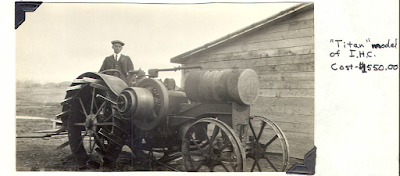52 Ancestors in 52 Weeks
Week 40
Prompt – Harvest.
Bill's maternal grandparents are Art &
Ida Jahnke.
This story and the photographs are taken
from an oral history of Art Jahnke taken by Bill's sister (Elaine)
in 1976.
In the year of 1914 when Arthur was 20 years old he took a 3
month course in book keeping at The Federal Business College in
Regina. At that time Art's parents were in Hatton, Saskatchewan where they
built and ran the local general store. Art was likely preparing to be part of the general store business.
In the spring of 1918, Art bought out
his cousin, Julius Jahnke's portion of the store. He ran the store
until its demise in January of 1920 when a fire that started in the business next to the store demolished their store. It wiped them out financially. Arthur decided not to restart the
general store and decided to go back to Killaly where his wife's
family was residing. He bought two half sections which
were two miles apart. It was unbroken land. While he started to
break in the soil and plant a crop, Ida's father built them a a 14 by
24 foot frame house which was only two rooms – kitchen and bedroom. Art, Ida and their oldest child, Elsie moved into the home in
October of the same year.
Art Jahnke's first tractor that aided
in the breaking of his homestead.
Elaine wrote about their first years on their homestead.
"That
first winter they had 1 cow, 16 horses, 21 chickens, plus 21 hogs in
spring. They bought 2 more cows for over the winter of 21 - 22, and a
new threshing machine in spring. Grandpa, his hired men, and 4
neighbors, all pitched in and did each other's threshing with most of
Grandpa's equipment and horse - teams. "
1922 farming photos of Art and Ida's homestead.
 |
| Circa 1922 - Haying on Killaly Farm |
 |
| Circa 1922 - Titan Tractor Threshing |
As the crop prices dropped he was glad
of his registered jersey herd.
Art and his family made it back to
Killaly, Saskatchewan in the summer of 1936. They helped the
renter's with the fall harvest and then moved back into the farm. I
guess their had been a contract for how they divided up the herds
etc. In 1937 the crop was almost non existent due to the dryness of
the land. He did have enough to harvest for seed the next year and
feed for their horses.
The crops of 1937 and 1938 were awful
and according to Elaine's history report, Art said that he would have
been in more financial trouble had it not been for the Jerseys.
Their “cream” cheques and Ida's faithful milking kept the farm
afloat.
Art and Ida farmed until their
retirement which I figure must be in the early 1950's. This
detailed description of their life during the 1920s to the end of the dirty thirties would have been forgotten or possibly
not known had it not been for the oral history that Elaine did. It still is a precious piece of
the Jahnke family history.
Wendy










No comments:
Post a Comment